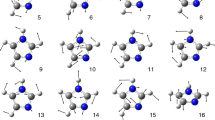Abstract—
Biliverdin is a product of heme catabolism. It is the pigment responsible for a greenish color sometimes seen in bruises. Biliverdin has been found in excess in the blood of humans suffering from hepatic diseases. Structure of biliverdin from catabolism process of heme is one of the cases that has been less discussed. In this research characterization of biliverdin analogues in the presence of hydroxide as a nucleophile and imidazole as axial ligands was investigated using the B3LYP method and the 6-31G basis set both in gas and solvent phases. By changing the central metal in the structure of billiverdin, some features such as gap energy, hardness and softness, electrophilicicity index and exact polarizability were studied and compared with iron.








Similar content being viewed by others
REFERENCES
P. R. Ortiz de Montellano and K. Auclair, in The Porphyrin Handbook, Vol. 12: Heme Oxygenase Structure and Function, Ed. by K. M. Kadish, K. M. Smith, and R. Guilard (Elsevier, New York, 2003), p. 183.
M. D. Bissell and Imliver, in Normal Function and Disease, Vol. 4: Bile Pigments and Jaundice, Ed. by J. D. Ostrow (Marcel Decker, New York, 1986).
L. Mosqueda, K. Burnight, and S. Liao, J. Am. Geram. Soc. 53, 1339 (2005). https://doi.org/10.1111/j.1532-5415.2005.53406.x
M. Unno, T. Matsui, and M. Ikeda-Saito, J. Inorg. Biochem., 113, 102 (2012). https://doi.org/10.1016/j.jinorgbio.2012.04.012
M. Sugishima, H. Sakamoto, Y. Higashimoto, et al., J. Biol. Chem. 278, 32352 (2003). https://doi.org/10.1074/jbc.M303682200
M. Unno, A. Ardèvol, C. Rovira, et al., J. Biol. Chem. 288, 34443 (2013). https://doi.org/10.1074/jbc.M113.486936
M. Gheidi, N. Safari, H. Bahrami, et al., J. Inorg. Biochem. 101, 385 (2007). https://doi.org/10.1016/j.jinorgbio.2006.10.012
H. Bahrami, N. Safari, and M. Zahedi, J. Inorg. Biochem. 100, 1449 (2006). .https://doi.org/10.1016/j.jinorgbio.2006.04.010
M.D. Davari, M, Zahedi, N. Safari, et al., J. Mol. Modeling. 15, 1299 (2009). https://doi.org/10.1007/s00894-009-0495-0
A. Taghizadeh, M. Daghighi, and P. R Jamaat. J. Porphyrins Phthalocyanines. 23, 1 (2019). .https://doi.org/10.1142/S1088424619501311
M. J. Frisch, G. W. Trucks, H. B. Schlegel et al., Gaussian 09, Revision A.02 (Gaussian, Wallingford CT, 2009).
R. G. Parr and W. Yang, Density Functional Theory of Atoms and Molecules (Oxford Univ. Press, Oxford, 1989).
C. J. Cramer, Essentials of Computational Chemistry: Theories and Models (Wiley, Chichester, 2002).
E. M. Siegbahn, Faraday Discuss. 124, 289 (2003). https://doi.org/10.1039/B211811B
L. Szterenberg, L. Latos-Grazynski, and J. Wojaczynski, ChemPhysChem 4, 691 (2003). https://doi.org/10.1002/cphc.200200611
G. I. Semushkina, L. N. Mazalov, S. A. Lavrukhina, et al., J. Struct. Chem. 61, 377 (2020). https://doi.org/10.1134/S0022476620030051
O. P. Charkin, Russ. J. Inorg. Chem. 58, 300 (2013). https://doi.org/10.1134/S0036023613030042
M. Khazri, K. Sahra, A. Milet, et al., J. Struct. Chem. 61, 844 (2020). https://doi.org/10.1134/S0022476620060025
O. P. Charkin, A. V. Makarov, and N. M. Klimenko, Russ. J. Inorg. Chem. 53, 718 (2008). https://doi.org/10.1134/S0036023608050100
Z. El Adnani, M. Mcharfi, M. Sfaira, et al., Struct. Chem. 31, 631 (2019). https://doi.org/10.1007/s11224-019-01435-5
J. Tomasi, B. Mennucci, and R. Cammi, Chem. Rev. 105, 2999 (2005). https://doi.org/10.1021/cr9904009
P. R. Jamaat, N. Safari, M. Ghiasi, et al., J. Biol. Inorg. Chem. 13, 121 (2008).https://doi.org/10.1007/s00775-007-0308-9
Lu Wei., Yuanbin She., Yanmin Yu., et al., J. Mol. Model. 18, 2483(2012).https://doi.org/10.1007/s00894-011-1279-x
R. G. Pearson, Chemical Hardness (Wiley, Oxford, 1997).
R. G. Parr and W. Yang., Density Functional Theory of Atoms and Molecules (Oxford Univ Press, New York, 1989).
R. G. Parr, L. v. Szentpály, S. Liu, J. Am. Chem. Soc. 121, 1922 (1999).https://doi.org/10.1021/ja983494x
ACKNOWLEDGMENTS
We are Thankful to Azad University of Tehran (central branch) for making available software and hardware (machine time) facilities to us and also thank the Research Council of Azad University of Tehran Markaz for support.
Author information
Authors and Affiliations
Corresponding author
Ethics declarations
The authors declare that they have no conflict of interest.
Rights and permissions
About this article
Cite this article
Taghizadeh, A., Jamaat, P.R. & Asli, M.D. The First Row Transition Metals on Stabilization of Biliverdin Complexes: Theoretical Study. Russ. J. Inorg. Chem. 66, 516–524 (2021). https://doi.org/10.1134/S0036023621040227
Received:
Revised:
Accepted:
Published:
Issue Date:
DOI: https://doi.org/10.1134/S0036023621040227




